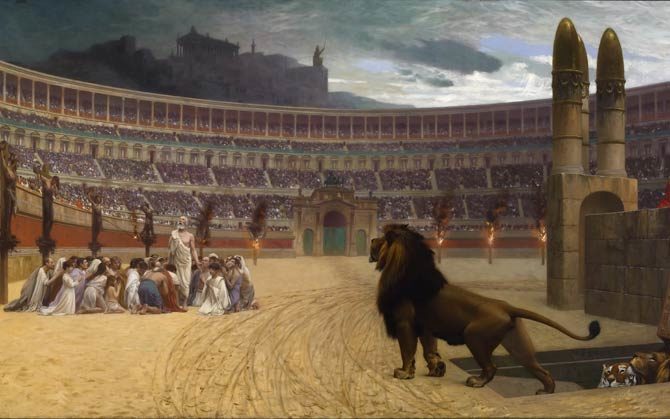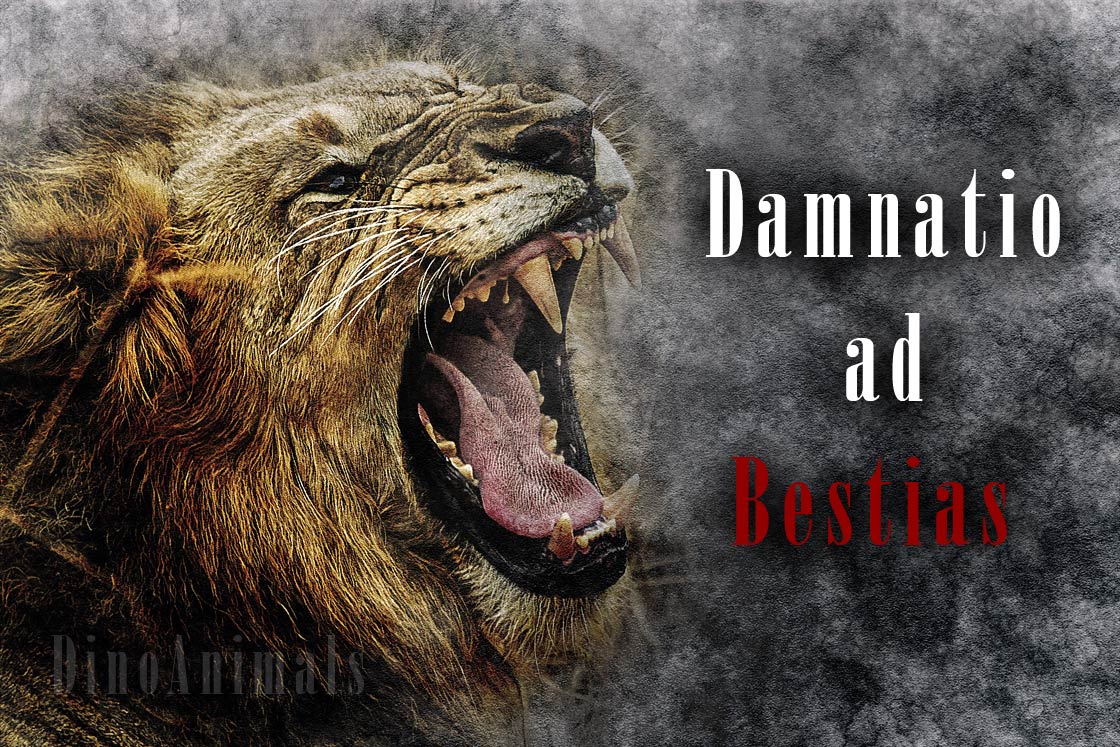Damnatio ad bestias – condemnation to beasts
Killed by wild animals
The death penalty has been practiced in almost all cultures throughout history. Its forms were varied. It was often required that the punishment be adequate to the committed deeds – for crimes that were exceptionally condemnable, a slow and painful death would await the guilty person. Such methods included throwing the doomed to be devoured to wild animals, that is damnatio ad bestias.
The term Damnatio ad bestias literally means “condemnation to beasts.” In ancient Rome, it meant punishment, whereby the condemned was to fight with animals or be eaten by them. Such punishment took place in public and was part of a larger spectacle during which viewers were presented with exotic animals. It was first used in the 2nd century BC. against Roman citizens of the lower classes. Later, this type of death sentence was given to those guilty of the worst crimes, runaway slaves, and also to Christians before the religion was legalized. The “executors” of the punishment were most often lions, less frequently other animals.

What was damnatio at bestias?
The Romans distinguished two types of killing by animals. In one case, a defenseless convict was simply released into the arena or tied to a column. On the other hand, the term “Damnatio ad bestias” originally referred to a different situation – the convict was prepared to fight. Sometimes he even took a lesson from a professional Venator (hunter); he was handed a spear, and sometimes a sword.
It even happened that the Venator accompanied the convict in the arena – though always out of reach of the animals. Later, the term applied to any kind of punishment consisting of throwing the convict into the arena, where the animals were released moments later – regardless of whether he was armed or not.

Animals in damnatio ad bestias
What animals did the convicts fight with? The most popular animals used in damnatio ad bestias were lions. They were brought to Rome especially for this purpose. The bears that were caught in Gaul and Germania and northern Africa, where they were quite common at the time, were almost as popular. Roman officials established special animal transport routes, and the provinces along these routes were obliged to provide food for them. In addition, the Romans brought elephants, buffaloes, wild boars, aurochs, tigers, leopards, hyenas and wolves to the circuses.
Virtually no animal attacks a man without a reason, and surrounded by a noisy crowd in the circus arena, it was stressed no less than the condemned man himself. Therefore, before the animals were released into the arena, they fell into the hands of the trainer. His task was to arouse their aggression, teach them to attack people and eat human flesh. For this reason, they could not have contact with other people whom they could accidentally attack. In Roman entertainment buildings, such as the Colosseum, there were special rooms, in which animals were kept, and passageways for taking them into the arena away from people.

History of punishment
It is not known exactly where the habit of damnatio ad bestias came from. The nature of the punishment suggests that it stems from the ritualistic religious sacrifice used especially where large predators were abundant. Such rituals were used, for example, in Egypt and India. He was also known in Asia Minor, the traces of which can be found in the Bible (the prophet Daniel was thrown into a cave full of lions). The original ritual gradually turned into a punishment for the most serious crimes – chroniclers who described Alexander the Great’s expeditions reported about throwing criminals to animals for devouring. A Macedonian named Lysimachus was sentenced to death and thrown to a lion, but he managed to defeat him with his bare hands.
In ancient Rome, such practices originally did not take place. The Romans themselves did not know lions, and King Numa Pompilius still in the 7th century BC. forbade human sacrifice. During the Punic Wars, they encountered a bloody spectacle involving animals. The Carthaginian commander Hannibal Barkas, wanting to entertain his soldiers thirsting for Roman blood and at the same time weaken the enemy’s morale, forced captured prisoners to fight elephants. As the Romans liked quite brutal (from our point of view) entertainment, they took over this custom themselves.
He organized the first fights with animals, initially with the participation of professional Venatores, in 189 BCE. Consul Marek Fulwiusz Nobilior on the occasion of the capture of the Greek city of Etolia. Later, in 186 B.C.E. Lucius Aemilius Paulus Macedonicus, who later became Macedonian troops in the Battle of Pydna, came up with the idea to make fighting animals a form of punishment for soldiers for the most serious offenses. As with the Carthaginians, the victims were initially armed. Finally, the Younger African Scipio, whose army had completely destroyed Carthage in 146 BCE, introduced the custom of punishing deserters by tethering to a column and releasing wild animals – the severity of the punishment was necessary to contain the wave of desertions after the initial successes of the Carthaginians.

Damnatio ad bestias as a judicial punishment
In the following years, the Romans understood that the nature of the punishment had a strong deterrent effect, and therefore damnatio ad bestias was regulated by law. The convicts were usually tied to a column or thrown into the arena naked and defenseless. This punishment was often performed en masse. Suetonius writes that Emperor Caligula ordered to punish merchants who inflated meat prices in this way.
Roman law precisely defined the penalties for certain crimes. First of all, deserters were sentenced to damnatio ad bestias. This punishment also affected poisoners (if they came from commoners), political criminals, initiators of rebellions, forgers and people who hired magicians to harm others. People committing crimes against the family were also thrown into the prey of wild animals: parricides and those who kidnapped children for ransom.
Damnatio ad bestias was an extremely severe kind of punishment. The convict could not make a will, and all his property was confiscated – the exception was the case when the convict was a military official with children. If a slave committed the crime, he could be sentenced to this type of death without a court sentence – in the case of a free man, a representative of the imperial authority had to be consulted.

Persecution of Christians
Damnatio ad bestias plays a special role in connection with the persecution of Christians in the first century CE. Initially, this religion played a marginal role, but from the point of view of the Romans, its followers committed serious offenses: they did not worship the gods, refused military service, did not recognize the emperor’s majesty, participated in night gatherings, which was against the law, used magical practices prohibited by law and professed a religion that was not recognized by law. That is why they were accused of, among other things, all-natural disasters. As a result, they fell victim to persecution for many years.
The first to decide to order damnatio ad bestias to Christians was the emperor Nero, who in 64 AD found them guilty of setting fire to Rome. The condemned were dressed in animal skins and released into the arena, where they were attacked by hungry dogs. In this case, it was not decided on larger, “nobler” animals, because the guilt of the alleged criminals was too great in the eyes of the Romans themselves. Successive emperors used similar practices, but with the use of larger animals. The application of damnatio ad bestias to Christians ended in AD 313, after the Edict of Milan, which made Christianity a legal religion.

Quo Vadis – “Christians for Lions”
In the novel Quo Vadis, Henryk Sienkiewicz presents the history of the persecution of Christians in the times of Nero. Christians are killed in the Colosseum arena, devoured by lions and tigers. The viewers also have an “entertainment” in which the great Germanic aurochs was used, on the ridge of which Lygia was located. Their entertainment, however, was spoiled by Ursus, who broke aurochs’ neck. If you are interested, see Quo Vadis – in chapter LXVI there is a description of Ursus’ fight.

In later times
Kara Damnatio ad bestias gradually faded away with the fall of the Roman Empire. In Rome itself, it was banned in 681. However, with the Eastern Empire, this punishment was still sometimes announced – in 1022 such a sentence was issued against the royal eunuch who helped in the plot of the generals against Emperor Basil II.
This custom has appeared one more time, the only time in modern times. In 1940, a spectacle was organized in the German concentration camp in Buchenwald, during which several prisoners were sentenced to fight a bear. It is possible that the organizers of the bloody spectacle did want to refer to an ancient custom, which is why it is sometimes referred to as the last case of damnatio ad bestias in history.

Interesting facts
- Some historians and naturalists believe that Rome’s huge appetite for wild animals that died en masse during spectacles contributed significantly to changes in the African ecosystem, such as the extermination of bears inhabiting its northern regions.
- Sometimes one animal was enough to kill many convicts. Cicero gives an example, when one lion killed 200 victims in succession.
- Damnatio ad bestias was a public execution, treated by the Romans as a form of entertainment for the masses and part of a performance in an amphitheater.

Recommended
- Cryptozoology
- Horses in mythology
- Werewolf, werewolves
- Giant snakes and sea monsters
- King Kong
- Godzilla
- Dragons
- Loch Ness monster
- Minnesota Iceman
- Yeti
- Bigfoot (Sasquatch)
- Yowie
- Alma
- Mokele-mbembe
- Beast of Gévaudan
- Orang Pendek
- Marozi
- Nadi Bear
- Aboriginal Rainbow Serpent
- Dyatlov Pass incident
- Animal records


















